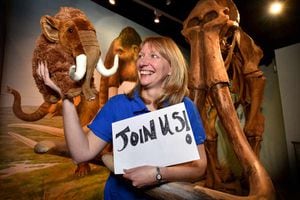Shropshire woolly mammoth find to be debated by leading historian
It is 30 years since one of the most unexpected discoveries put Shropshire on the prehistoric map, as a woman walking her dog noticed the bones of a 14,000-year-old creature that had been pulled out of the ground by workers.

The discovery of Shropshire's woolly mammoth bones at Condover in 1986 has become almost legendary – and is even disputed by some, who believe it may have not quite happened as the official account goes.
Now, one of the leading historians behind the unearthing of the ancient animals will be coming to the county this weekend from the Natural History Museum, to talk about the discovery and its legacy.
Professor Adrian Lister will be at the Shropshire Hills Discovery Centre, in Craven Arms, on Saturday evening along with others who were involved in disinterring an almost-complete adult mammoth skeleton and bones from at least four juveniles.
His talk will be the cornerstone of a mammoth-themed weekend at the venue, which has a full-size replica of the adult male.
As for the fossilised bones themselves, today some can be seen at Shrewsbury Museum and Art Gallery in a temperature controlled cabinet, while the majority are held in storage at Ludlow Museum Resource Centre.
New research from the Natural History Museum, in London, has suggested the creatures fell into a 'kettle hole' – lakes resulting from the melting of a mass of ice trapped in glacial deposits.
Dr Victoria Herridge, a scientist at the museum who worked with Prof Lister on the find, and has presented Channel 4's Walking Through Time, said the multiple mammoths probably fell in and drowned, at different times rather than together.
She said: "These kettle holes would have been honey-traps.
"They would have been surrounded by rich vegetation that attracted mammoths, possibly herds of them and inevitably a few fell in."
In a journal report on the finds Prof Lister called the Condover mammoths "a remarkably well-preserved assemblage of partial skeletons unique in western and central Europe.
"This revealed the skeleton of a 28-year-old adult male woolly mammoth, largely complete except for the cranium, the partial skeletons of four or five juveniles in the age range three to six years, plus sparse remains of a sub-adult individual." He said Condover finds are so important because the adult mammoth is by far the best-preserved woolly mammoth skeleton found in Britain – and the specimens are the only late-glacial skeletons in western Europe, proving mammoths were still roaming the earth thousands of years later than they were previously thought to have died out.
The Shropshire bones are still the subject of research and debate.
There is even debate over exactly how they were discovered – or rather by whom.
The 1986 discovery is said to have been made by chance by Eve Roberts, of Bayston Hill, who was walking her dog with husband Glyn near the quarry at Condover when they spotted the huge bones dug up and thrown on a spoil heap. Mrs Roberts says she then called in the museum service on her own initiative. However, quarry worker Michael Ryan, an excavator driver, has said that credit for finding the bones is shared by himself and his brothers Christopher and Gary, Gareth Westcott, and Maurice Badderley who was operating machinery used in the work.
Mr Ryan says they uncovered a huge bone, but were unsure what it was.
Although too big for a cow buried in a foot and mouth epidemic, they thought it might be a horse.
He said: "We saw this lady walking up the side of the quarry with her husband and their dog. I asked if she knew if there was any foot and mouth in this area and she said not that they could recall.
"I told her we had discovered some bones and was not sure whether they were horse bones and as we were unable to get off the site to make a phone call asked if she could phone somebody and find if there was any foot and mouth round here. She said she would and phoned the museum."
After the discovery the bones were briefly put on display at Cosford Aerospace Museum before being kept for years in climate-controlled storage at a Cardiff museum.
A replica of the adult's skeleton was created and is now at the Discovery Centre, and the originals are at Ludlow.
For more information on the Discovery Centre's mammoth weekend, as well as tickets for Prof Lister's talk and other events, call 01588 676060 or visit www.shropshirehillsdiscoverycentre.co.uk





